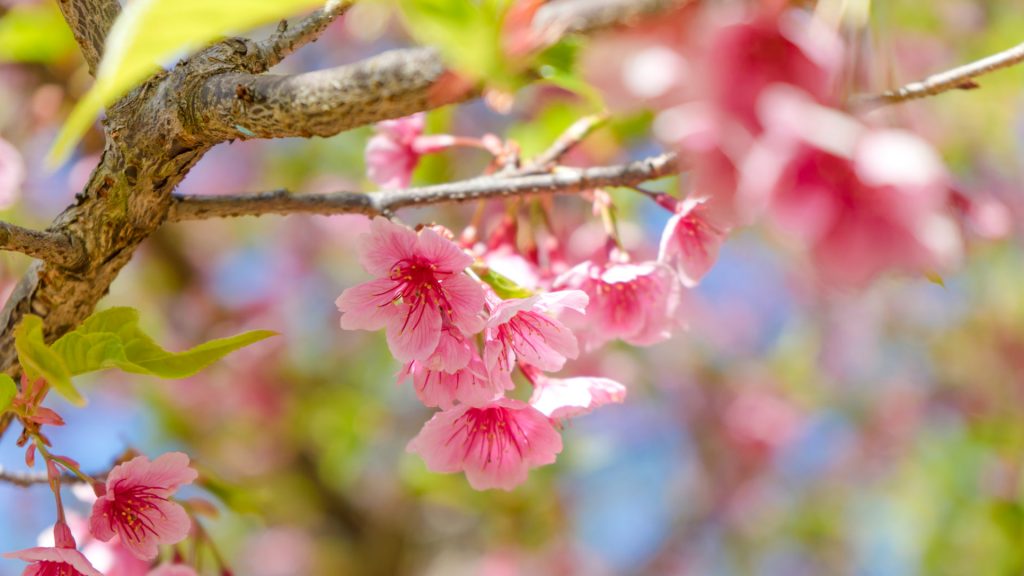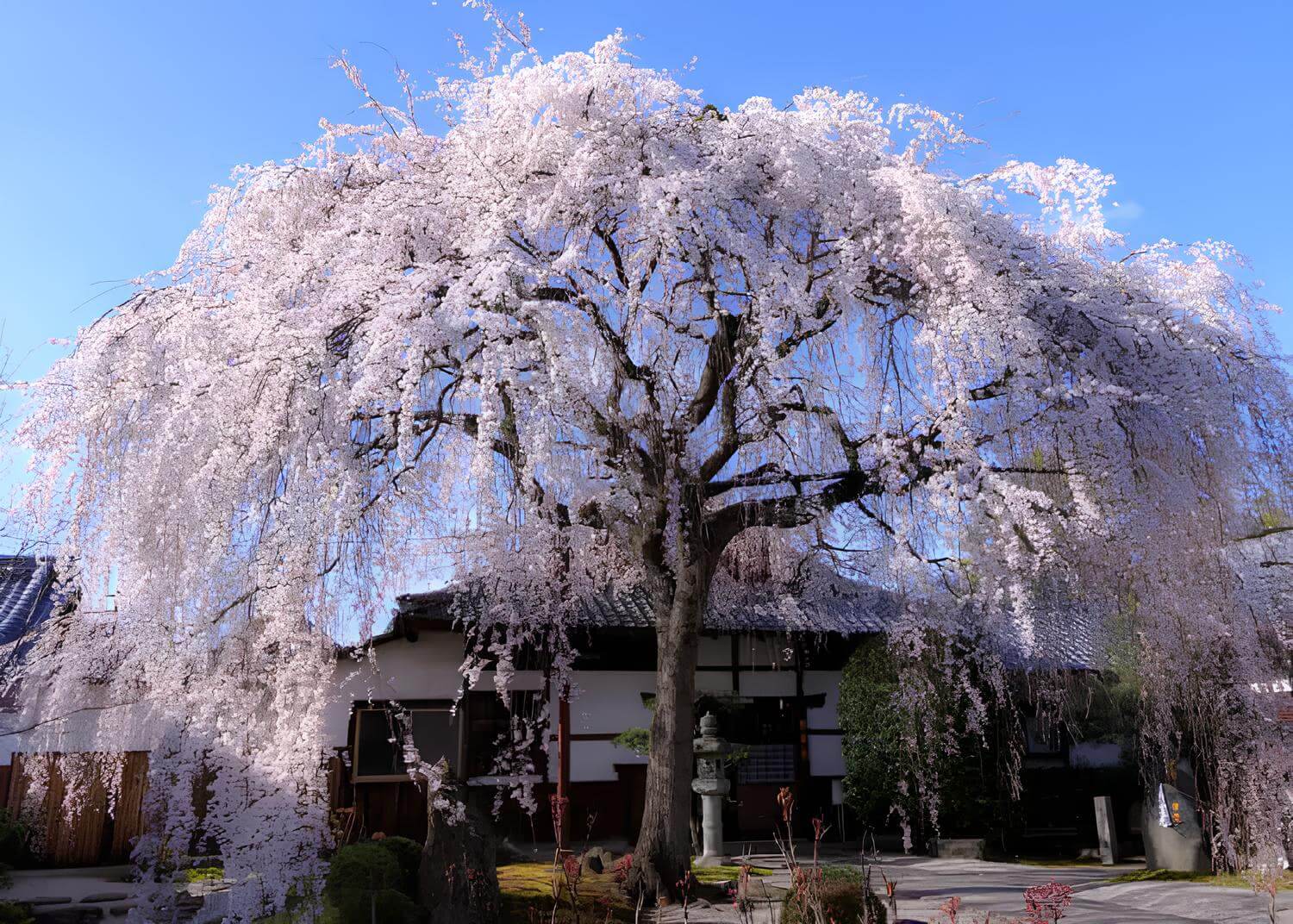Colorful flowers can beautify any landscape, and trees with pink flowers are often a popular choice.
When considering pink flowering tree identification for your home with a play garden for kids or a bungalow with an expansive yard, trees with colorful blooms never fail to offer visual delight.
Now, when talking about visual delight, a tree with pink flowers, scientifically known as Sakura in the case of Japanese cherry blossoms, never goes out of style.
You should consider it if you have space to plant a beautiful tree.
A tree with pink flowers or any other color provides beautiful visuals and often offers fruits and other ecological benefits.
However, choosing the best tree to match your landscape and understanding pink flowering tree identification may get complicated.
But no worries! Here, we have the list of the 18 best flowering trees, each with unique charm and characteristics.
So, keep reading to find out which one is for you and your garden!
Pink Flowering Tree Identification Guide with 18 Best Options
1. Flowering Cherry Trees

Japanese cherry blossom trees, botanically known as Prunus serrulata, are considered one of the most beautiful trees in the spring.
Cherry trees bloom with pink and white flowers, giving a dreamy landscape to any garden or yard.
These flowers bloom in clusters and look like the tree is covered in pinkish-white candy floss.
However, these flowers do not last long and lose their petals in 2 to 3 weeks.
Different types of cherry trees bloom at different times, so you can enjoy a longer blooming period by choosing multiple varieties.
These trees also give fruits but are mostly grown for their ornamental value.
Identification Marks: Recognized by their stunning pink and white blossoms, which cover the tree like candy floss in spring, creating a dreamy, ephemeral landscape.
2. Magnolia Trees

The Magnolia tree is an ancient species believed to have appeared even before bees.
It is hypothesized that its flowers evolved to encourage pollination by beetles, although this is not definitively proven.
Magnolias come in various sizes and bloom colors. You can get a multi-stemmed shrubby tree of around 8 feet or an extended 70 feet tall majesty.
The large flowers of Magnolia, known scientifically as Magnolia grandiflora, blossom in the spring and fill the air with an exotic sweet fragrance.
Also, you can choose your flowers from various colors like white, pink, red, and purple.
The flowers often bloom before the leaves, offering a soothing view.
Note that Magnolia trees require specific care, so it’s recommended to consult experts for best practices.
Identification Marks: Characterized by their large, exotic, sweet-smelling flowers in white, pink, red, and purple; blooms appear before the leaves, offering a striking spring display.
3. Persian Silk Trees
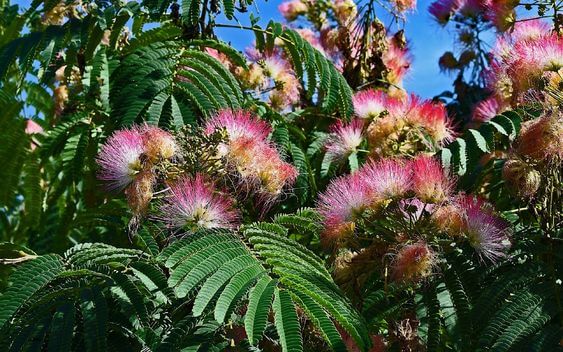
The Persian silk tree, also known as Mimosa (Albizia julibrissin), is known for its fragrant pink fluffy flower heads.
This tree has medium green leaves, which perfectly set off its pretty pink flowers. Flowers on this tree bloom from early summer until mid-summer and thrive best in warm climates.
This tree is also known for its skincare and beauty benefits.
One who knows about trees from the genus Mimosa may confuse Persian silk trees with them, as the flowers on both genera look similar but are different.
Identification Marks: Notable for their fragrant pink fluffy flower heads, set against medium green leaves; blooms in early to mid-summer, thriving in warm climates.
4. American Redbud Trees
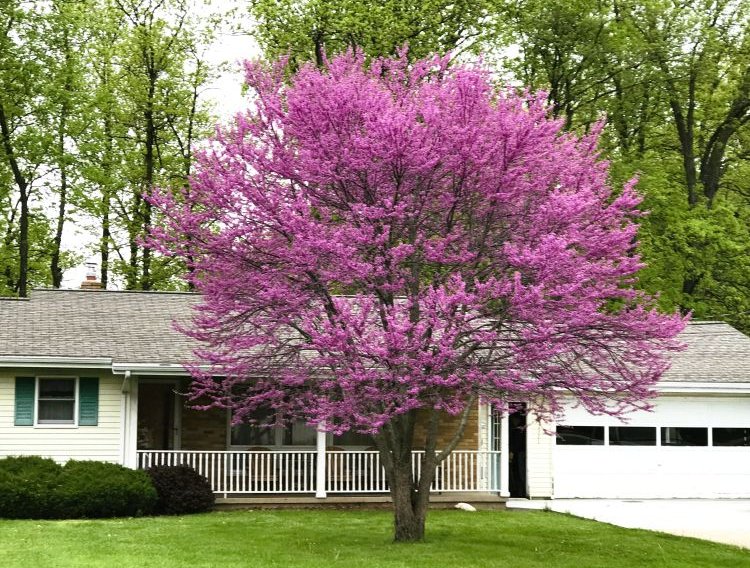
The American redbud tree, a small flowering tree with pink flowers, is a deciduous species that bloom flowers in all pink shades before the leaves from spring until summer.
Though famous for their small pink flowers, some varieties bloom in white.
These trees usually grow to a medium size and are known for attracting many pretty singing birds and butterflies.
However, different types of American redbuds have different sizes. You can choose the size that looks good in your garden or yard.
Flowers on this tree grow in masses like a pea. This creates an eye-catching landscape.
Identification Marks: Identified by their pink flowers blooming in various shades before the leaves in spring, attracts birds and butterflies, with some varieties having white flowers.
5. Pink Trumpet Trees
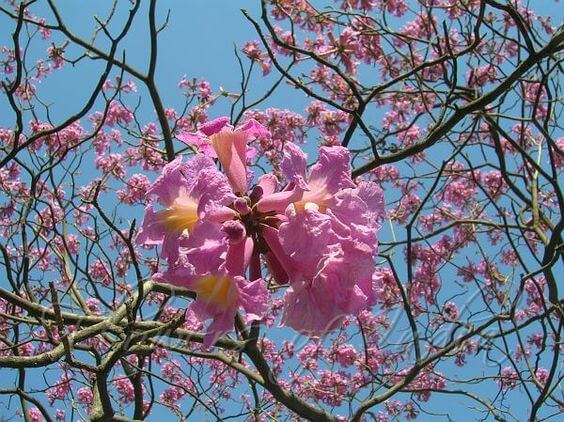
Also known as Pink Poui and Rosy Trumpet, Tabebuia impetiginosa is a neotropical tree with pink flowers.
This long-living and semi-deciduous tree blooms with delicate pinkish-white flowers with a yellow center.
These flowers grow in a trumpet shape and cluster from late winter till early spring.
These trees grow at a moderate rate. From being a slim pyramid in its young ages, this tree becomes a broad silhouette of around 30 to 40 feet when mature.
The pink trumpet tree grows best in subtropical zones but thrives well in both wet and dry climates.
Identification Marks: Distinguished by delicate pinkish-white flowers with a yellow center, growing in a trumpet shape; blooms in late winter to early spring.
6. Dogwood Trees

Dogwood trees, encompassing over 50 species like Cornus Florida, offer great visual delight with their beautiful flowers in various colors.
Flowers on these trees bloom in beautiful colors like pink, red, purple, and white.
All its flowers have a dense cluster of stamens at the center in shades of yellow and green.
Also, deciduous leaves in some dogwood species turn into shades of burgundy or purple in the fall.
With summer and fall foliage, the trees also have winter branching habits and offer fall fruits.
The flowering dogwood species thrive well in moist zones but also grow in drier habitats.
Moreover, their height usually goes around 20 to 40 feet, and they may spread even more than their height.
If you decide to get one of these trees in your garden, it would be the right choice because they offer long-term service of up to 80 years.
Identification Marks: Known for their beautiful flowers in pink, red, purple, and white, with a dense cluster of stamens in the center; leaves turn burgundy or purple in fall.
7. Rose Trees

For those who love roses, rose trees, also known as rose standards, are an excellent choice.
These are not actual trees but rather rose bushes grafted to grow like trees.
They come in a wide range of bright colors, allowing you to choose the perfect hue to match your landscape.
However, they are not ideal for very cold climates and require significant care during winter. Generally, rose trees can survive for about 8 to 10 years.
Though you can provide the trees with external protections, they hardly make it through extreme winters.
In case the climate is freezing, crucial care is needed to make them survive.
Identification Marks: Grafted rose bushes resembling trees, offering a wide range of bright colors; requires significant care, especially in cold climates.
8. Thunderchild Crabapple

The Thunderchild crabapple tree, known for its blush pink blossoms, offers dark purple leaves once the flowers bloom.
These trees are known for their strong disease resistance and excellent winter hardiness.
They thrive in zones 3 to 7, making them a versatile choice for many gardeners. The small apple-like fruits of this tree are perfect for making jams and jellies.
The flowers also have a sweet and delicate fragrance to give you the best spring vibes.
You would get everything in your garden- fruits, flowers, and foliage.
A beneficial fact about the thunderchild crabapple is that this tree is strongly disease-resistant (no fireblight at all) because of its rigid constitution.
Identification Marks: Features blush pink blossoms and dark purple leaves post-bloom; known for strong disease resistance, winter hardiness, and small apple-like fruits.
9. Red Horse Chestnut

The red horse chestnut is a medium-sized tree popular in large gardens and public parks.
This tree with pink flowers is a cross between the horse chestnut and red buckeye, creating an eye-catching display with its dark green leaves and pink-red flowers that bloom in clusters.
While the fruits are poisonous to humans, they attract wildlife such as squirrels. This tree is hardy in zones 4 to 10 and grows well in full sun with moist soil.
The tree grows up to 30 to 40 feet tall when mature. You can quickly grow this tree with pink flowers in a full sun position with moist soil.
Identification Marks: Medium-sized tree with dark green leaves and pink-red flowers in clusters; known for its use in large gardens and public parks.
10. Crape Myrtle
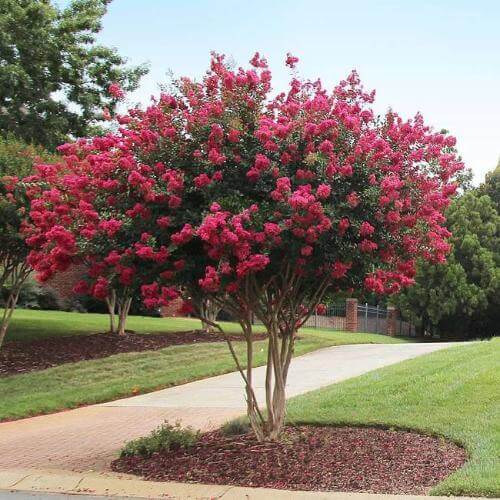
Crape Myrtle, scientifically known as Lagerstroemia, is a highly favored choice for gardens due to its stunning and prolonged blooming period.
This versatile plant can be grown either as a deciduous tree or as a more compact shrub, making it suitable for a variety of garden sizes and styles.
If you are in search of a resilient and long-lasting tree with pink flowers, the Crape Myrtle stands out as a superior option.
These trees are renowned for their longevity, often thriving for 50 years or more with the right care.
The flowers of the Crape Myrtle are particularly striking, with their distinct wrinkled petals that bear a resemblance to crepe paper.
They bloom in a vivid spectrum of colors, ranging from deep reds to soft pinks and vibrant purples.
This range of hues ensures that gardeners can select a variety that perfectly complements their landscape design.
Identification Marks: Favored for its prolonged blooming period, available as a tree or shrub; distinctive wrinkled petals in colors from deep reds to soft pinks.
11. Flowering Almond
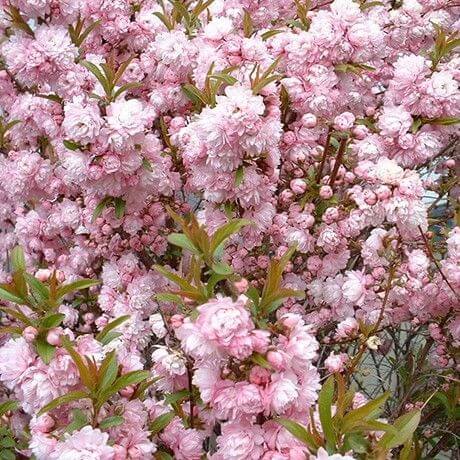
The flowering almond tree, while not producing edible almonds, offers stunning pink flowers in spring.
This deciduous tree blooms with double petals, adding a unique charm to your garden.
It usually grows to about 12 feet tall and is hardy in zones 4 to 8.
The flowering almond tree is also considered drought tolerant and can thrive in both full sun and partially shaded spaces.
This tree can be a long-living addition to your landscape, with a lifespan of up to 50 years.
Identification Marks: Offers stunning pink flowers with double petals in spring; a small tree reaching about 12 feet, hardy and drought tolerant.
12. Cherokee Chief
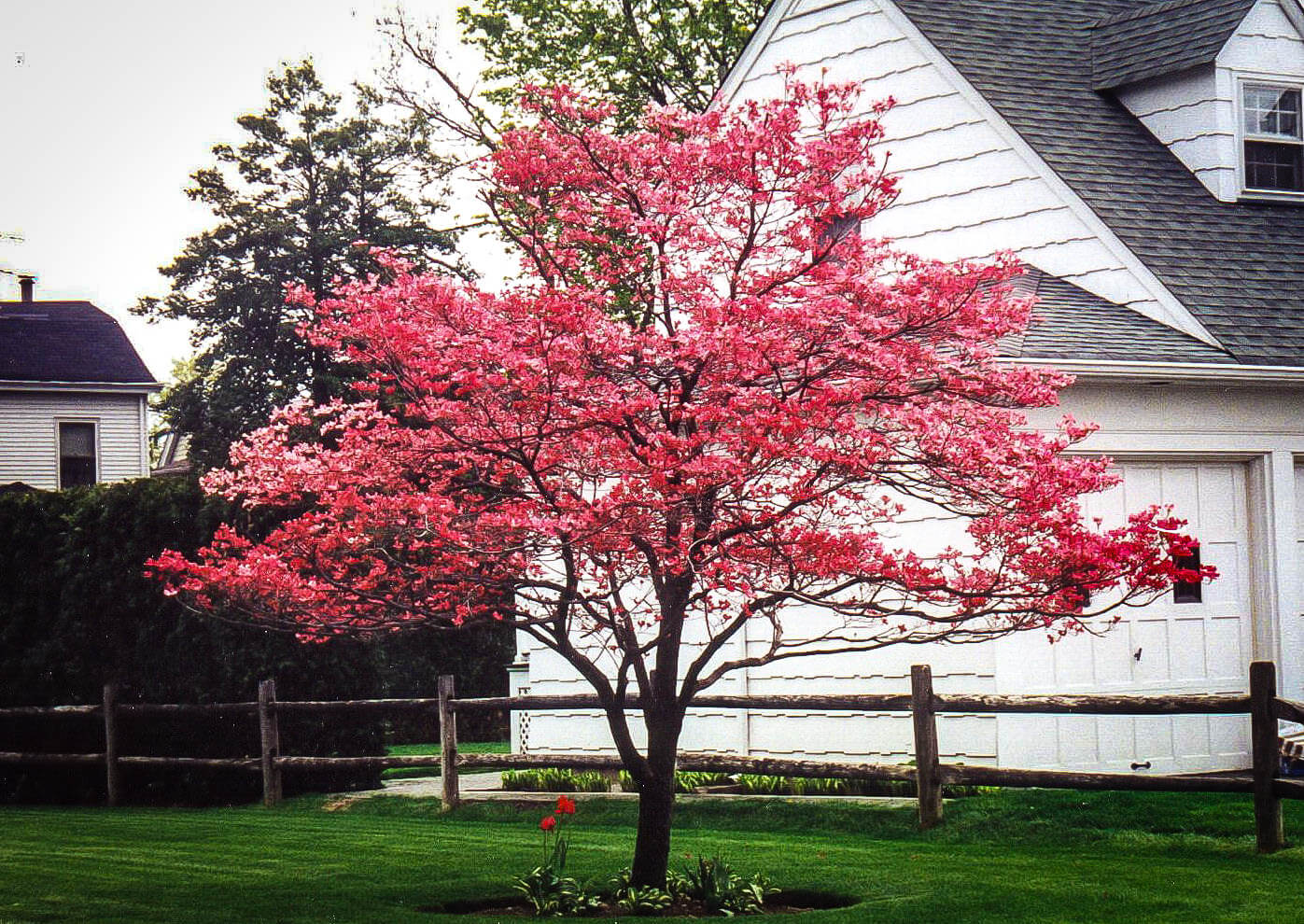
The Cherokee Chief, a variety of dogwood trees, is notable for its striking pink flowers.
This small tree, perfect for pink flowering tree identification, blooms early in spring, enhancing any garden with its showy flowers in April and May.
It’s also known for its attractive fall foliage, turning red, and its small red inedible fruits that are favored by birds.
The Cherokee Chief thrives in zones 5 to 9 and requires minimal care, making it an excellent choice for both home gardens and public spaces.
However, a significant drawback of these trees is that they have a risk of diseases.
Identification Marks: A variety of dogwood with striking pink flowers, blooming early in spring; known for attractive fall foliage and small red inedible fruits.
13. Wisteria Trees

The wisteria tree, cascades of flowers ranging from creamy pink to lilac-blue, is a showstopper in any spring garden.
This versatile tree can be trained along walls or grown independently.
It requires full or partial sun and some patience in the initial years.
With proper care, a wisteria tree offers a stunning visual display and a sweet fragrance, making it a favorite among garden enthusiasts.
A wisteria tree usually grows up to 6 to 10 feet with a spread of around 8 to 9 feet. You can grow it in full or partial sun.
However, one must be patient and provide the tree with complete care in its initial years for great results.
Identification Marks: They are recognizable by their cascading flowers in creamy pink to lilac blue; they are versatile and can be trained along walls or grown independently.
14. Azalea Trees

Azaleas, often cultivated as shrubs and trees, are a fantastic choice for anyone interested in pink flowering tree identification.
These versatile plants offer a stunning array of bright pink, purple, and red blooms, making them ideal for various landscape designs.
Whether you’re looking to create striking border plants, lush masses, or standalone features in your garden, azaleas can easily adapt to each role.
They thrive in well-drained, humus-rich soil, a testament to their preference for nutrient-rich environments.
Regular mulching is essential for these plants, as it helps to retain moisture and protect their shallow root systems.
With diligent care, azaleas can grace your garden with their beauty for up to 50 years, a testament to their longevity and enduring appeal.
Identification Marks: Cultivated as shrubs or trees; bright blooms in pink, purple, and red; adaptable for various landscape designs, thriving in humus-rich soil.
15. Rhododendron
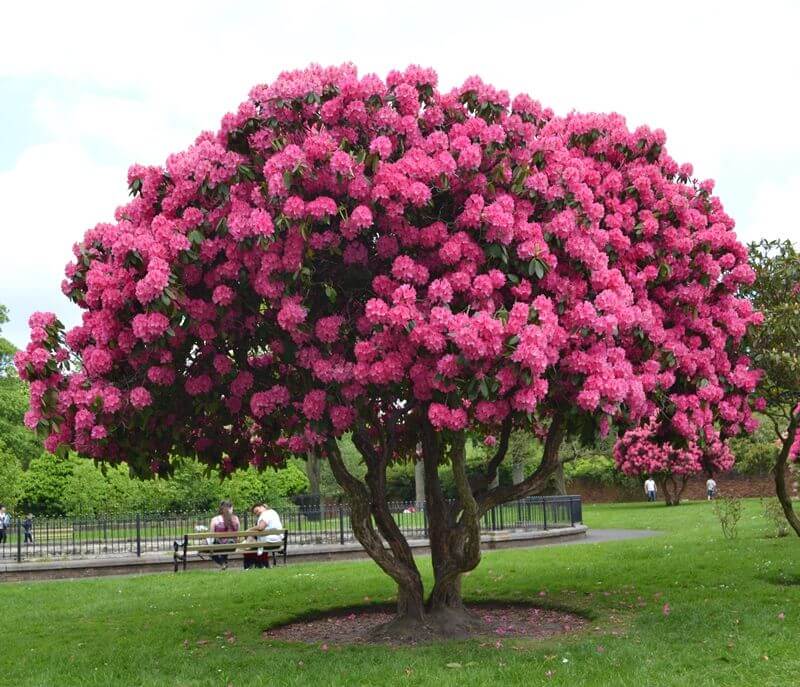
Rhododendrons, a diverse genus with over a thousand species, are renowned for their spectacular flowers in a variety of shades, including pink, red, white, orange, and yellow.
These plants offer an array of sizes and shapes, providing endless possibilities for gardeners to find the perfect match for their landscape.
Rhododendrons distinguish themselves from other flowering trees with their preference for shaded positions, especially during the winter months.
This characteristic makes them ideal for cooler, sheltered parts of the garden.
However, gardeners with pets should exercise caution, as rhododendrons are known to be toxic to animals.
Their lush foliage and vibrant blooms make them an excellent choice for adding a touch of elegance and color to your garden.
Identification Marks: Offers spectacular flowers in shades including pink, red, and white; prefers shaded positions, diverse in size and shape.
16. Weeping Cherry
The Weeping Cherry tree, a timeless classic for pink flowering tree identification, captivates with its elegant, pendulous branches that bloom profusely with pink and white flowers.
Available in a range of sizes, from quaint dwarf varieties to majestic tall trees, the Weeping Cherry fits into various garden settings.
It flourishes in full sun and well-drained soil, indicating its need for optimal growing conditions.
Regular watering and mulching are crucial for maintaining the health and vigor of these trees.
With a life expectancy of 10 to 20 years, the Weeping Cherry tree is a fleeting beauty and a long-term resident of your garden, offering years of breathtaking spring displays.
Identification Marks: Characterized by pendulous branches with profuse pink and white flowers, they are available in various sizes and require full sun and well-drained soil.
17. Hawthorn

Hawthorns stand out with their vibrant blooms that adorn the tree in April and May.
These trees, which can live from 50 to an impressive 150 years, are known for their attractive pink flowers and edible berries.
These berries are often used in herbal remedies, showcasing the tree’s medicinal value.
However, they are known to have side effects like headaches and nosebleeds in some cases.
The Hawthorn tree is an excellent addition to any garden, offering aesthetic appeal and wildlife habitat.
Its resilience and longevity make it a wise choice for gardeners looking for a long-lasting, beautiful, and useful tree.
Identification Marks: Known for vibrant blooms in April and May; long-living with edible berries used in herbal remedies, attractive to wildlife.
18. Jane Magnolia

Part of the charming “Little Girl” series of hybrid magnolias, the Jane Magnolia is renowned for its beautiful, tulip-like flowers in hues of pink, purple, and white.
These trees bloom in late spring, a strategic time to avoid frost damage and fill the air with their sweet fragrance.
They require soil that is moderately moist, neutral, or slightly acidic, highlighting their need for specific soil conditions to thrive.
Growing as either a large shrub or a small tree, the Jane Magnolia can reach 10 to 15 feet, making it a versatile choice for different garden spaces.
This tree’s elegant appearance and manageable size make it a favorite among garden enthusiasts.
Identification Marks: Part of the “Little Girl” series, blooms with tulip-like flowers in pink, purple, and white; late spring bloom to avoid frost damage.

